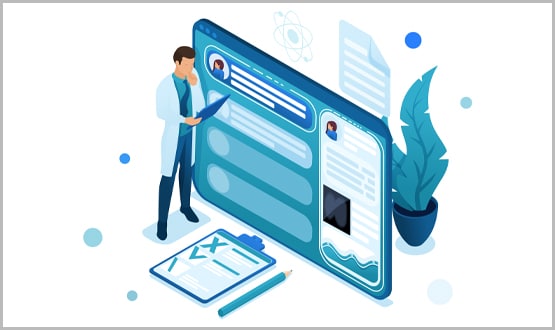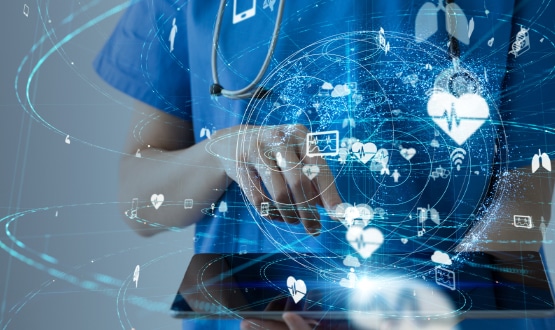Mind The Gap – How to Effectively Bridge the Divide Between Paper and Digital
- 15 September 2022

The National Health Service is on a journey to embrace digital health, which is key to its strategy as it recovers from the Covid-19 pandemic and plays an important part in the NHS Long Term Plan published in 2019. Whether it’s virtual appointments, faster processing of patient information or digital storage of patient records to enable access to the full picture for both health providers and patients, digital has a critical role to play in the transformation of the health service.
Digital improvements
Many gains have been made: the nhs.uk website provides access to high quality health information and digital services; citizens and health professionals can access over 70 apps that have been assessed and approved via the NHS Apps Library and the NHS App provides access to NHS 111 online, the user’s GP record, the ability to book appointments, update data sharing preferences and register for organ donation. 93% of England’s 7,300 GP practices now use the Electronic Prescription Service (EPS) and more than 67% of their prescriptions are delivered via EPS, saving the NHS £136 million in the three years from 2013 to 2016.
Just because great strides have been made doesn’t mean the NHS can be complacent about the transition to digital healthcare as even prior to the pandemic, demand for healthcare had been rising across all services and sectors. For example, in emergency care, there were 1.7 million more attendances and 1.1 million more admissions at major (type 1) A&E departments in 2019/20 than there were in 2011/12. Demand is continuing to rise, particularly in the area of chronic diseases where the proportion of total global deaths is expected to increase to 70% by 2030, according to the United Nations.
A paperless future?
The aim of improving healthcare services through digital transformation is urgent and necessary but is paperless part of that vision? The idea of going paperless has been around for a while, with the NHS announcing significant paperless targets as early as 2015. But whilst many trusts are on a journey to reduce paper usage, removing it entirely is going to be a tough task because the reality is that paper simply works best in some settings.
From a member of the medical support staff filling out a form for lunch orders on a ward to a nurse or doctor filling out a clinical information form, paper provides a quick and easy means to record information and probably always will. That’s not the end of paper’s story, however. The critical takeaway is to recognise paper’s value as a quick and easy delivery mechanism – a single step – in an information capture journey.
Paper’s value and the Fujitsu Image Scanners fi-8000 opportunity
The true value of paper in a digital health environment comes from how it is leveraged and thereby linked to positive digital outcomes which have a beneficial impact on healthcare staff time and patient care. Paper’s value is generated in the next step after it is used to record information. To illustrate this, imagine a scenario where a member of a clinical team is moving around a hospital ward doing a regular check in with patients. This person doesn’t want to push a computer on a trolley, or carry a laptop, or rely on any other technology when they have patients waiting. Therefore, they use paper to take down any necessary information because paper forms offer a quick and easy way to record information, which allows them to focus on engaging with patients. Once their round is finished, they approach the nurse’s station where the hand-written forms are inserted into a fi-8000 image capture device. Using the fi-8000’s state-of-the-art capture technology, the pages are rapidly scanned, understood, information they hold uploaded, and recorded in the correct patient files within the clinical software. Imagine the time savings and secure data sharing benefits.
As expected in an image capture device that is suitable for a hospital environment, the fi-8000 range delivers the highest levels of reliability, reduces power consumption, and consistently provides the perfect feed thanks to its Automatic Separation Control. In addition, the range is designed to deliver maximum uptime and real-world productivity gains thanks to enhanced multi-feed detection, which prevents misfeeds and jams allowing the devices to capture up to 90 double-sided pages per minute. With the Overscan Control function automatically adjusting the scanning area to prevent image loss on slightly skewed documents, the need for rescanning – which wastes precious time – is eliminated and uninterrupted operation ensured. Finally, with their Clear Image Capture technology ensuring industry-leading OCR accuracy rates, fi8000 devices support a vision where hospital staff have full visibility of the patient data they need digitally, but without the stress of manually inputting it or changing their approach.
Website: www.fujitsu.com/uk/fi8000
Email: Daniel.melly.pfu@fujitsu.com
LinkedIn: www.linkedin.com/company/fujitsu-pfu-emea-limited
YouTube: Information Capture Community





2 Comments
Unless the scanned information is truly “understood”, structured, associated with the correct patient’s hospital spell, and SEARCHABLE – it will simply be a huge, digitised pile of paper that wastes users’ time as they search it for relevant information.
I’m intrigued by the potential of lightweight paper tablets, to replace bits of paper, and hope that one day there will be accurate and instant digitisation and organisation of patient information written/drawn on these so that we can do away with the need to “approach a nurse’s station and insert hand-written forms into an image capture device” …
I understand this is a sponsored article, but the title is something that is very important for Trusts that do not have an EPR but on working towards one. I would love more insight into how other Trusts are managing a slow conversion to digital and how to better manage the pathways around patient care etc.
Comments are closed.